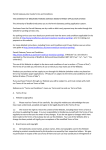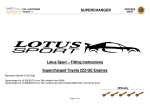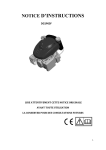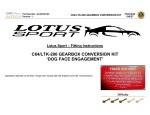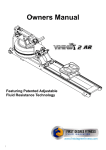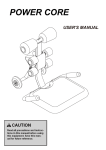Download Lotus Sport & Performance Centre – Fitting Instructions
Transcript
Lotus Sport & Performance Centre – Fitting Instructions Six Point Harness & Competition Seat These fitting instructions are aimed at Elise 111R and Exige S2 owners. Fitting Level (1=Easy, 5=Hard) - 4 Parts Required Driver’s competition seat Fitting kit Harness kit Tools Required Lotus service manual (A120T0327J) Ramp Torque wrench Electric drill 3.5mm and 8.5mm drill bits 16mm and 25mm hole saws Rivet gun 13mm swan neck ring spanner 5mm hexagonal key Silicon sealant and gun Mini hacksaw Deburring tool Disclaimer Lotus accepts no liability for any direct, indirect or consequential damage or loss (including as a result of negligence) arising from the application of these fitting instructions by any person. For the avoidance of doubt, this does not affect your statutory rights and Lotus does not exclude liability (if any) to you for death or personal injury arising out of Lotus’ negligence. Please note that the fitting of any Lotus approved part(s) by anyone other than a Lotus approved engineer may invalidate the vehicle warranty. This equipment is intended for use on private property and/or racing tracks only and is not suitable for use on public roads as it may constitute a criminal offense. Accordingly, the purchaser of the equipment and all persons who may use the equipment must ensure that it is not used on any public road. Lotus Motorsport Ltd cannot and does not accept any liability arising directly or indirectly from the use of the equipment other than in respect of death or personal injury caused by its negligence. The purchaser’s statutory rights when dealing as a consumer are not affected. 1 Instructions PLEASE READ INSTRUCTIONS BEFORE ATTEMPTING ANY REWORK NOTE: Instructions are tailored to left-hand drive vehicles however all operations can be easily mirrored to suit right-hand drive. 1. By referring to the Lotus Service Manual, remove the following items from the car: • Driver’s seat • Driver’s side 3-point seat belt • Rear bulkhead trim panel • Rear bulkhead square foam blocks (if fitted) • Upper rear console (stowage pocket) • Lower rear console • Gear lever cover 2. If the vehicle does not have a mounting bar to enable fitting of the shoulder harnesses this should be ordered under P/N A122A0032F. 2x M10x 30mm screws and suitable washers will be required to fit the mounting bar between the extremities of the roll hoop. Also, either: A. A new rear bulkhead trim panel should be ordered under P/N A122U0017K for lefthand drive vehicles (P/N A122U0018K for right-hand drive) to retain the rear speakers. This rear bulkhead trim panel will be a direct replacement requiring no modifications. B. The original rear bulkhead trim panel can be retained but – depending on the vehicle model/variant – the speakers may need to be removed to allow for fitting of the mounting bar. Also, the rear bulkhead trim panel will need to be fettled by cutting out a portion of material at each end to allow for the mounting bar to be connected to the roll hoop. Picture 1. Vehicle with mounting bar Picture 2. Standard rear bulkhead 3. Once the selected parts are available, fit the mounting bar to the roll hoop and then fit the rear bulkhead trim panel (NOTE: For torque settings refer to the Lotus Service Manual). Obtain the two shoulder straps from the 6-point harness kit and fit these to the mounting bar following the instructions and safety precautions provided with the harness kit. 2 4. Referring to Picture 3, measure the distance between the front mounting points for the seat runners (highlighted with a yellow box) and mark the midpoint “A” on the edge of the chassis cross-member. Place the crotch strap bracket on the chassis floor-pan against the chassis cross-member and locate it centrally with respect to point “A”. Mark the locations of all four holes in the bracket, remove the bracket and drill 2x Ø8.5mm holes through the two chassis floor-pan points. By referring again to Picture X, mark a point 30mm in front of the edge of each Ø8.5mm hole from the underside of the vehicle. Cut out 2x Ø25mm holes through the floor skin only so as to allow access to the rear of the chassis cross-member. Drill 2x Ø8.5mm holes through the two chassis cross-member points marked earlier. RH-FR RH-RR Chassis Cross-Member = 2x Ø25mm 2x Ø8.5mm --- A X Chassis Floor-Pan 30mm = LH-FR LH-RR Picture 3. Left-hand drive vehicle driver’s side floor-pan 3 5. Referring to Pictures 4 and 5, place the crotch strap bracket into position and offer the spreader plate to the underside of the floor pan aligning the holes with those on the plate. Feed 2x M8x25mm button head screws fitted with plain washers through the spreader plate, the floor pan and the crotch strap bracket securing these with 2x M8 flanged K-nuts. Similarly, feed 2x M8x25mm button head screws fitted with washers through the crotch strap bracket and the chassis cross-member securing these with 2x M8 flanged K-nuts. With the aid of a torque wrench, set the torque for all four M8 screws to 25Nm. Obtain the crotch strap from the 6-point harness kit and fit this to the crotch strap bracket following the instructions and safety precautions provided with the harness kit. Spreader Plate Screw B Screw B Screw A Crotch strap Bracket Picture 4. Spreader plate– underside Screw A Picture 5. Bracket – floor-pan 6. By referring to Picture 6, place the first strap nut and spreader plate in the left-hand rearmost corner of the floor-pan from the underside of the vehicle with the strap nut facing downwards. Ensure that the strap nut is closest to the left-hand edge of the spreader plate and that the longest side of the spreader plate sits against the chassis extrusion as shown. Mark the location of the strap nut on the chassis, remove the spreader plate and cut out 1x Ø16mm hole through the floor skin only so as to allow clearance for fitting the strap nut and spreader plate with the strap nut facing upwards. Place the strap nut and spreader plate into position and mark the location of the holes on each corner of the spreader plate. Remove the spreader plate and drill 4x Ø3.5mm holes through the floor skin only. Apply a bead of silicon around the edge of the spreader plate top-side, place the strap nut and spreader plate into position and secure it to the chassis with 4x rivets. Obtain 1x eyebolt and screw it hand-tight into the strap nut from inside the chassis and making sure it is oriented as per Picture 7. Chassis Extrusion Eyebolt LH-RR Strap Nut Spreader Plate Picture 6. Outer strap nut– underside 4 Picture 7. Eyebolt – floor-pan 7. Refer to Pictures 8 and 9, drill 1x Ø3.5mm pilot hole through the floor-pan where a slot locates the gearshift assembly bracket as indicated. From the underside of the vehicle, line up the second strap nut and spreader plate with the pilot hole with the strap nut is facing downwards. Ensure that the strap nut is closest to the right-hand edge of the spreader plate and that the longest side of the spreader plate sits against the chassis extrusion as shown. Mark the location of the strap nut on the chassis, remove the spreader plate and cut out 1x Ø16mm hole through the floor skin only so as to allow clearance for fitting the strap nut and spreader plate with the strap nut facing upwards. Place the strap nut and spreader plate into position and mark the location of the holes on each corner of the spreader plate. Remove the spreader plate and drill 4x Ø3.5mm holes through the floor skin only. Apply a bead of silicon around the edge of the spreader plate top-side, place the strap nut and spreader plate into position and secure it to the chassis with 4x rivets. Obtain 1x eyebolt and screw it hand-tight into the strap nut from inside the chassis and making sure it is oriented as per Picture 7, page 4. Chassis Extrusion 1x Ø3.5mm Gearshift Assy Bracket Picture 8. Bracket – floor-pan Spreader Plate Strap Nut Picture 9. Inner strap nut – underside 8. Obtain the gear lever cover and referring to Picture 10 remove the portion of material from the rear left-hand section with a mini hacksaw as indicated and deburr all sharp edges with a deburring tool. Refit the gear lever cover to the gearshift assembly and ensure there is enough clearance for the eyebolt. Material to be removed 40mm MIN Gear lever cover Picture 10. Gear lever cover detail 5 9. By referring to picture 11, assemble 2x triangular brackets to the inner side of the lefthand seat runner. Feed 1x M8x25mm hexagonal head screw fitted with a washer through hole V6 of the runner and the middle hole H5 of the front triangular bracket. Secure the front bracket to the runner with 1x M8 self-locking nut and washer. Feed 1x M8x25mm hexagonal head screw fitted with a washer through hole V14 of the runner and the top hole H10 of the rear triangular bracket. Similarly, feed 1x M8x25mm hexagonal head screw fitted with a washer through hole V16 of the runner and the bottom hole H10 of the bracket. Secure the rear bracket to the runner with 2x M8 selflocking nuts and washers. Repeat the operation to obtain a right-hand seat runner; ensure that the triangular brackets are fitted to the inside of the runner. With the aid of a torque wrench, set the torque for all six M8 screws to 25Nm. H: 1 2 3 4 5 To secure spacer between bracket and seat H: 6 7 8 9 10 V: 1 2 3 4 5 6 7 8 9 RH-FR BRACKET (X4) To secure bracket on inside of runner V: 10 11 12 13 14 15 16 17 18 RUNNER (X2) RH-RR SPACER (X4) Picture 11. Driver’s competition seat fitting kit 6 10. Again, by referring to picture 11 on page 6, fit the left-hand seat runner assembly to the driver’s competition seat. Feed 1x M8x45mm hexagonal head screw fitted with a washer through hole H2 of the front triangular bracket. Slide 1x 13.5mm spacer onto the M8 screw protruding from the bracket and feed the remaining visible portion of the screw into the left-hand front hole found on the base of the driver’s competition seat. Similarly, feed 1x M8x45mm hexagonal head screw fitted with a washer through hole H8 of the rear triangular bracket. Slide 1x 13.5mm spacer onto the M8 screw protruding from the bracket and feed the remaining visible portion of the screw into the left-hand rear hole of the driver’s competition seat. Repeat the operation to fit the righthand seat runner; ensure that the washers are fitted to the inside of the triangular brackets. With the aid of a torque wrench, set the torque for all four M8 screws to 25Nm. 11. Carefully lower the driver’s competition seat assembly into the car and line up the holes in the seat runners with those indicated in Picture 3 on page 3. Reutilise the screws from the original driver’s seat to loosely secure the new seat into position. By sitting in the seat, ensure that its position with respect to the steering wheel and the pedals is suitable. If this is not the case, remove the seat and adjust the distance of the seat to the pedals by relocating the triangular brackets on different “V” holes found on the seat runners. The angle of the seat to the steering wheel can be similarly adjusted by relocating the seat on different “H” holes found on the triangular brackets. Once the location of the seat has been fine-tuned, remove the cushion from the base of the seat to reveal an aperture, carefully lower the seat into the car and feed the crotch strap through this aperture. Secure the seat to the floor of the vehicle with the original screws (NOTE: For torque settings refer to the Lotus Service Manual). Refit the cushion to the base of the seat and feed the shoulder straps through the respective eyelets on the back of the seat. 12. Once seated inside the car, adjust the length of the crotch strap and that of the shoulder straps following the instructions and safety precautions provided with the harness kit. Check that all the screws pertaining to the seat are tightened according to the Lotus service manual and/or the above fitting instructions. 7







